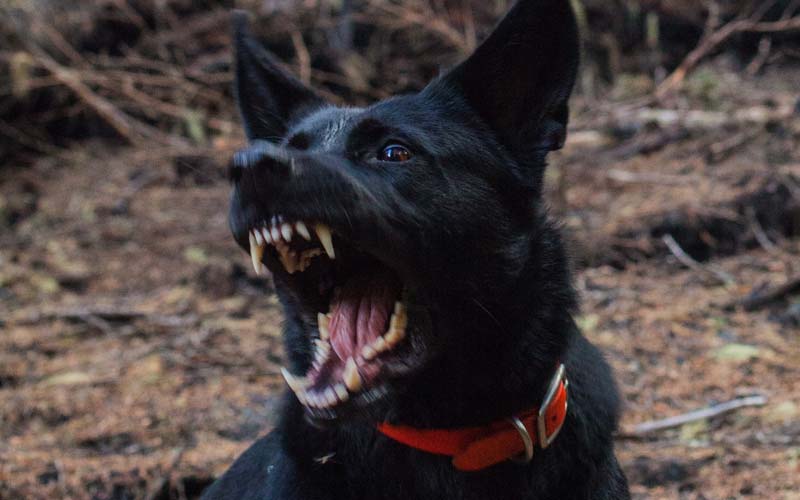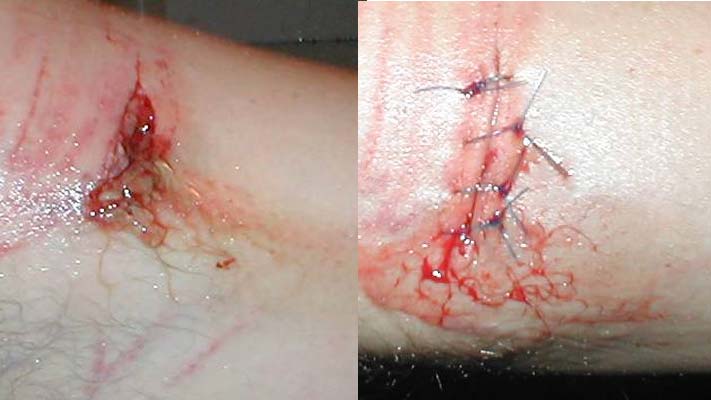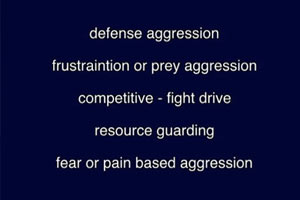Dealing with the Aggressive Dog
The TV show 20/20 recently aired a segment on aggressive dogs biting people. I learned of this from an email prior to the show. The individual (who did not sign their name) begged me to complain to 20/20 about doing an episode about aggressive dogs who bite. Needless to say, I did not respond to the email but I did watch the program. The fact is, the show was rather well done and accurate. If I were to criticize anything, I would have liked to see it go into more detail on overly aggressive dogs and how to deal with them.

Here are just a few of the facts that were explained by 20/20:
- 90% of dog bites happen to people who know the dogs
- Most dogs that bite are family pets
- 60% to 70% of dog bites are to children or the elderly
- 40% of the bites to children result in loss of facial tissue (lips, cheek, etc.)
- Half of the claims made on homeowners insurance are related to dog bites
- Overly aggressive dogs have a number of different causes that all can be traced back to two different areas: poor breeding or poor socializing
An overly aggressive dog does not just rear its ugly head one day and become a monster. Throughout its life, it has displayed warning signs that it's not a normal, friendly pet. As a youngster, it may have acted like a timid animal that wanted nothing to do with strangers or strange places. Or it could have slowly developed into a bully after growling at people who came near its toys or food dish.
We can't really blame the average pet owner for missing many of the early warning signs. If someone has never raised a dog before, he has enough problems teaching a puppy not to pee on the floor or to come when called. But this same pet owner still has the responsibility to recognize and deal with their adult dog that becomes overly aggressive at inappropriate times.
There are several different types of aggression that dogs will display. Below I have listed the main areas of aggression. I then explain how to deal with the problems related to each type of aggression. Understanding where aggression has its roots will help people understand the methods used in controlling the problem.
Types of Dog Aggression
- Dominant Aggression
- Territorial Aggression
- Fear Aggression
- Prey or Predatorial Aggression
Dominant Aggression
Many people think it's cute when a young puppy growls and snaps at fingers that get too close to the food bowl or toys. They laugh and show their friends how tough this little pup is going to be when it grows up.
What they don't understand is that this dog is showing early signs of dominance. The truth is that this pup is probably going to grow up to be aggressive to family members in addition to strangers. Early growling can easily develop into an adult that tries to take control of the house. Now, if this is an 8-pound Schipperke, there isn't much chance of that happening. But if it's a baby Rottweiler who is going to grow into a 120-pound monster, then this is a definite problem.
Dominant Aggression needs to be controlled from the minute it's recognized, (no matter how young or how small the dog is). I have just written an article titled Dealing with the Dominant Dog. People need to read this article if they feel that their dog falls into this category.
An interesting point that 20/20 made is that more dog bites come from small dogs than from big dogs. The University of California did a study and found that dogs under 16 pounds are more likely to snap at people. My personal feeling is that "SMALL DOG OWNERS" do not perceive their dogs as being very dangerous. Many large dog owners make some attempt at controlling aggression problems, (even if it's just giving the dog away or having it put to sleep). While the small dog owners often tend to ignore the problem and feel that their little terrier is just being cute when it growls at kids or guests that try and sit on the couch next to it. The fact is small dogs can bite SMALL KIDS in the face.
To get a handle on aggression, people need to understand that above all else dogs are pack animals. Above and beyond all other inherited instincts they live a pack life that has been bred into them since the beginning of time. Their very nature demands a pack order and if one is not set up for them, they will take it upon themselves to develop their own pack order by which they live. If they do not look at the owner as the pack leader, they will take it upon themselves to become the pack leader. This is why many dogs will accept commands from the man in the house but not the wife or vice versa. It all comes down to how the dog views a person according to pack order.
The first thing that needs to happen when trying to get control of a dominant dog is to have his pack order changed. He needs to be moved to the bottom of the list in terms of pack order. This is done by controlling every aspect of the dog's life. Dominant dogs do not sleep on the bed or in the bedroom. The best place to sleep goes to the pack leader. Dominant dogs never eat from the table. In fact, they are crated during mealtime and are always fed "after dinner," (lower pack members always eat last).
It is absolutely imperative that the dominant dog goes through obedience training and learns to mind. This is a very important part of establishing pack order. The obedience training should not be the straight motivational approach. Motivation is used but it must be tempered with corrections for not minding. I explain exactly how to do this in my video titled Basic Dog Obedience. If the dog's dominance has developed to a point where it tries to attack the handler when it's corrected, then it's time to muzzle the dog and get some professional help.
Another important point in establishing pack order is to remember the dog only plays with the toys the handler provides and the handler always takes possession of these toys at the end of the play session. The toys are ALWAYS put away and the dog is not allowed to play with them when the handler is not there. To leave them out only further stimulates a possessiveness in the dog for that toy. If the dog gets overly possessive towards a particular toy, then that toy is put away and never played with again.
People in protection dog sports are taught to play tug with their young pups. This is fine as long as the handler always takes the tug away from the dog at the end of the play session. It's also OK to offer a food treat when the tug is taken away, (or another toy like a tennis ball.) One should not allow the dog to win the tug and run off with it so that the dog ends up laying and chewing on it for an extended period of time. This only builds a possessive attitude which can be a problem later on as an adult. If your goal is not protection training a tug may not be a good choice for a toy with a dog that shows too much aggression at an early age.
In the end, the bottom line on establishing pack order is that dogs are always happier not having to be the pack leader. They are calmer and more relaxed when they realize that the pack leader is the one that controls their life.
If you notice that a pup is showing signs of aggression at an early age it is a good idea to have him neutered at about 6 months of age. Early neutering has a significant effect on an aggressive temperament. But if your goal is to raise a protection dog then you will be forced to deal with the aggression problem in other ways. Neutering an adult dog (older than 18 months of age) has little or no effect on an already maturing dog with aggression problems.
Territorial-Based Aggression
Territorial aggression can be seen as a form of dominance. The dog learns to look at the yard, the car, or the house as his. The truly dominant dog may even think he needs to make a statement over who owns what, but in most cases, the territorial dog is going to defend his property from strangers.
The perfect example of territorial aggression is demonstrated towards the mailman or meter reader. People think it's the uniform that sets the dogs off towards the friendly letter carrier. That is not the case. What really happens is this: the mailman approaches and the dog barks. The mailman deposits the mail and leaves. In the dog's eyes, the person left because he (the dog) barked at them. So through repetition, he learns that if he barks at these people, they will leave. Some dogs learn that if they bark very aggressively people will leave faster.
People that have guard dogs want territorial aggression in their dogs. They want a dog that barks (and sometimes even bites) a stranger that enters their house in the middle of the night. But these same people don't want their dog to attack everyone that gets in their car or every guest that comes over for dinner. No one likes the idea that they have a Cujo that has to be locked in the basement every time one of the kids has a friend over to play. Dogs with problems like this are showing territorial aggression.
Controlling territorial aggression begins with establishing yourself as the pack leader. In the wild, it's the pack leader that tells the rest of the pack where their territory is. Not allowing the dog to look at the backyard as "his backyard" is the first step. Some people think that leaving the dog in the back yard during the day is good for the dog. The fact is that most dogs will lie down and sleep all day waiting for the owner to come home. He's a pack animal and he will wait for members of his pack to return. The dog could just as easily sleep in the house, dog kennel, or a dog crate.
If people want a dog to become a protection dog, they must train their dog both in obedience and protection work. The dog must learn that there are rules of engagement that are established by the pack leader. A good personal protection dog is a dog with good nerves and sound temperament. My police dog is the perfect example. He is very approachable. He can go into school rooms with small children, he is no threat to the UPS men and women that come into the office every day or to any visitor that comes to the kennels. But this same dog has bitten a good many bad guys while working as a police dog. I would not want to be the person that tries to come into my office where he is left at night. Through training he knows that the office at night is a "free-fire zone" and anyone that tries to get in at night is fair game.

The left photo is a wound from a dog bite that resulted from breaking up a dog fight. The right is the same wound after being stitched up.
Fear-Based Aggression
We have all heard the term "fear biter." These types of dogs want nothing to do with strange people or strange places. They learn that if a stranger tries to approach, and they show a little tooth and growl the stranger will back away and leave them alone. This behavior manifests itself into a dog that will try and bite someone it doesn't know the minute that person turns its back on them. Fear biters prefer to bite from the rear as this presents much less of a threat to them than a frontal attack. So a fear biter is a learned response from a dog with very bad nerves.
Fear biters are almost always dogs that have weak temperaments and poor nerves. They are a product of bad breeding. Many people mistakenly confuse fear biters as dogs that have been abused at an early age. How often have you heard someone say "I got my dog from the shelter and it was really abused by someone before I got it. That's why it acts the way that is does."? The fact is, that most of these dogs ended up in the pound or shelter because of the bad temperament they had to begin with. They were not made shy, they were born shy.
With that said, there are dogs that have bad temperaments because of poor environments - which basically means poor socializing.
There are a few things that people can try before making the decision to put a dog down or before they give it away:
- One of the things to do with dogs that are shy of people in given situations is to set up training sessions that build confidence and security. For example, if your dog is shy of people on walks, then have a friend meet you on a walk and give the dog a meat treat. If your dog is aggressive towards the neighbor's kids, have them come over when the dog is in the crate and feed the dog meat treats through the door of the crate. If they are afraid to let the dog eat from their fingers, then put the meat treats on a toothpick and stick it through the bars of the cage. Some dogs will quickly learn that kids and strangers are not all bad.
- If you are unlucky enough to already own a fearful shy pup, the main solution begins with socializing the dog. Take it everywhere you go. Make sure to control its environment to the extent that you do not place it in a situation where it is extremely afraid. If it shows concern, pick it up or get down on your knees, pet and calm it down. Show it that there is nothing to be afraid of.
- Obedience training and socializing are the best solutions for most shy dogs. It is very important to be very careful with your pup around older dogs. Not every adult dog you see likes puppies. I have found that pups that are attacked at an early age turn out to be dog aggressive as an adult. These pups quickly learn that if they growl at strange dogs they will be left alone. This action manifests itself into the adult dog that will attack another dog for no apparent reason. These dogs live under the code "attack him before he attacks me" principle. If you have a dog like this, you need to read my article titled How to Break Up a Dog Fight Without Getting Hurt.
- Rather than be forced to walk your dog in the middle of the night (when no one is around) you would be better advised to get a muzzle (like one of the inexpensive plastic ones that we sell) and use it during your socializing and obedience lessons. If you plan to use a muzzle in training, make sure to get the dog used to wearing it before starting to train with it on. Put the muzzle on just before feeding for an hour or so for a week, or just before going out in the back yard to play. Let the dog think it always gets the muzzle on just before doing something that it likes to do.
The bottom line is that some dogs are so poorly bred that no amount of training or socializing is going to overcome the fears and ghosts in their heads. It's my opinion that these dogs should be put to sleep and the owner should make a bigger effort to pick a pup from sound parents the next time they get a dog.
Prey or Predatorial Aggression
Some breeds of dogs are more prone to prey aggression than others. Your herding breeds have a great deal of prey drive. They will instinctively chase something that moves. This can be disastrous if it's an untrained dog that decides its prey is a running child.
Once again the most effective thing to control this form of aggression is obedience training with the emphasis being placed on the recall and the down. Some dogs in high prey may respond better to the "down command,” while others may respond better to the "recall." The bottom line is you need to be able to stop your dog if he is chasing after someone or something.
You can build your control during play exercises by making the dog "lay down" before he is allowed to chase a thrown ball (use a long line or electric collar if necessary). You can teach him the 2-ball game where one toy is tossed and when the dog is 1/2 way to the ball he is called back and sent after a second ball that is tossed as soon as he returns. This is most easily trained with low-level electric training. You can even down your dog, throw a toy, and then go and get it yourself to toss it a second time before he is allowed to get it. This all works towards establishing you as the pack leader and builds control into the dog.
While the wolf-hybrid may be the most dangerous animal out there in terms of aggression towards kids, let's not underestimate the untrained dominant border collie or any other breed. This does not have to be a breed-specific concern.
Children with Dogs
All children should be trained in how to deal with strange dogs. If children understand some basic rules in how to interact with dogs, there would be a lot fewer kids being bitten every year. Here are a few ideas:
- Always ask permission to pet a dog before attempting to do so.
- They should never be allowed to tease a strange dog.
- If a strange dog approaches a child, they should:
- stand still
- be quiet
- do not make direct eye contact with the animal (dogs relate direct eye contact to a challenge)
Breaking Up a Dog Fight without Getting Hurt Podcast
Dog fights are violent, loud, and dangerous events. I get emails every day about dog fights. As I wrote this description, I got two emails. In the email, the family had two dogs. Their female GSD had just killed their Dachshund. In the second email, this family's dog had just been in a fight with a neighbor's dog and done $1,400 damage.
In the mid-1990's I wrote an article on How to Break Up A Dog Fight without Getting Hurt. That article is still on my website. This 52-minute podcast is an update of that article. The information in the podcast has more details on making the decision of even trying to step in to break up a fight. We discuss many methods used to break up fights as well as how to break up a fight when you are alone. There is an also extensive section on preventing dog fights.
You can listen to the podcast in a variety of ways:
Listen on Spotify Listen on Apple Podcasts Listen on Amazon Music DownloadConclusion
If all dogs were well socialized and had gone through basic obedience lessons (either at home or in classes), there would be a lot fewer problems with dominant and over-aggressive dogs. A little bit of education on the handler's part also goes a long way towards producing an animal that is not a danger to society.
One last important point is this: "handler aggression towards the dog is not going to eliminate aggression in dogs." This never works. In most cases, these dogs have found out that the solution to their problem is aggression. If the handler decides he is going to "kick some butt" with this dog, the dog may decide that the handler is the problem and he has learned to solve his problems with aggression.










Ask Cindy.